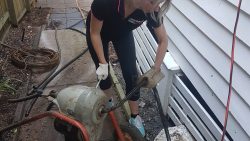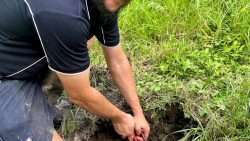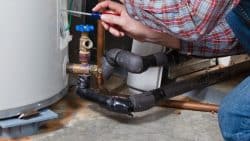
How To Isolate Your Water Supply
Cold Water, Hot Water and Individual Fixtures
Knowing how to isolate your water supply can be a real-life saver when you have a plumbing emergency. A rapid response to a water leak can prevent significant property damage and the need to engage insurance companies. Whether it’s a burst flexible hose, a pressure leak, or a malfunctioning tap, knowing how to isolate the water is the first step in managing an emergency.
This blog will provide basic instructions and show common examples of where to isolate your water supply. We cover houses, townhouses, and units, as well as the types of valves: the mains cold water isolation, unit shut-offs, hot water isolation, and individual fixture stop taps. Not all properties have all these options available, so we strongly recommend familiarising yourself with your home to see what options are available to you.
Some of the information in this blog is specific to Brisbane, Australia. If you live outside of Queensland, refer to your local utility provider for instructions on where to locate your water meter.
Pro Tip:
Shutting off your water supply is also a good idea if you are going away on holiday. The last thing you want to come home to is a flooded home from a burst pipe.

Cold Water Isolation – Houses
Mains Water Isolation Valve at Water Meter:
Your water meter is usually located in a plastic box at the front of the property. Inside that box should be a valve to shut off your water supply. The most common location for a water meter box is the nature strip or driveway at the front of a property. The box can be in a grassed area, in a garden bed, or encased in concrete.
What can I do if I can’t turn off the valve?
Depending on the age and condition of an isolation valve, you may find that it is difficult to isolate. Some older valves can become completely seized, or the handle can strip off. If you can’t turn it off by hand, you can try WD40 and use a shifter with a screwdriver to aid in turning off a stiff valve. If all else fails and you can’t shut off the water, contact QUU Faults and Emergencies on 13 23 64 (Brisbane/Queensland only).
An example of a DIY tool you can use to help shut off the water using a shifter and a screwdriver


Did you know? We attend to 99% of jobs the same day!
Please call, and we will be able to assist you today.
Our team will give you real, honest advice and a great price. All our work is 100% guaranteed.
Who owns and maintains the water meter and isolation valve?
In standalone houses, the utilities provider installs and maintains the shut-off in the water meter box. In Brisbane, this is Queensland Urban Utilities (QUU). In townhouses or housing complexes, QUU or the body corporate can manage the water meter and isolation.
Note: This is general advice only and may not be accurate in all cases. We recommend consulting QUU, the strata manager, Body corporate or building manager for information specific to your property.
I’ve looked everywhere and can’t find my water meter box. What do I do?
Sometimes, water meter boxes can be tricky to find. They can be buried in a garden bed or covered by grass and leaves. Plumbers often have a knack for tracking down a water meter box. QUU can also help with some guidance over the phone.
Below is a link to QUU’s Interactive Asset location Map. This can be a useful tool to help locate your water meter and other plumbing infrastructure.
QUU’s Interactive Asset Location Map
Pro Tips:
We recommend regularly checking that the valve is accessible inside the meter box and removing any dirt build-ups, debris, or plants obscuring access.

Fig 1: An example of a water meter box encased in concrete

Fig 2: An example of an older-style Brisbane City Council water meter Box
Mains Water Shut Off Inside Property Boundary
Some homes have an isolation valve located after the water meter, generally at the first point of entry into the house. Having an isolation valve installed externally can be useful and allow the water to be shut off quickly.

Fig 3: This is an example of an isolation valve located at the water service’s first point of entry into the house. it is installed before the boundary pressure reduction valve (PRV).
Cold Water Isolation – Units
Most unit complexes have individual shutoffs for each unit. The most common locations for isolation valves are in a centralised meter cabinet or located inside the unit.
Centralised meter cabinet

Fig 4: This is an example of the individual unit isolations valves for a large unit block
Individual water meter

Fig 5: This is an example of the individual unit isolation valves in a body corporate common area.
Isolation Inside the Unit
Unfortunately, there is no standard position for an isolation valve within a unit. Below are some examples of the most common locations based on our experience as maintenance plumbers. These valves can be notoriously difficult to find, even for an experienced plumber.
Under the Kitchen, Bathroom or Laundry Sink

Fig 6: This is an example of a water isolation valve located via an access panel on the bottom shelf of the kitchen cabinet.
Inside a Service Duct

Fig 7: This is an example of a service duct with an access panel. The unit isolation is positioned behind the vent.
If you can’t locate your individual unit’s isolation valve, we recommend contacting your building manager or Body Corporate representative. Some older unit complexes do not have individual unit shutoffs, so the whole building must be shut down.
Pro Tip: If your unit does not have an individual isolation valve, we recommend installing mini shutoffs wherever possible to isolate fixtures in case of emergency. More on this will come in the next section
Hot Water Isolation
Isolating the hot water supply is often more straightforward than isolating the cold-water supply. If you have a leak from a hot pipe, you can also keep the cold water on until you can arrange for a plumber to attend.
Fig 7: This is an example of a service duct with an access panel. The unit isolation is positioned behind the vent.

Fig 8: This is an example of a where to find the isolation valve on an electric hot water system.

Fig 9: Common hot water isolation valves.
For more information, see our Hot Water Help – Emergency Shutdown page
Individual Fixture Isolation:
Rather than isolating the water supply to your home, it may be possible to isolate individual fixtures. Mini stop taps are commonly found on toilets, mixer taps, and appliances such as dishwashers, washing machines, and ice maker fridges. The advantage of this is that it allows for quick isolation and servicing.

Fig 10: Mini stop taps located under a sink to shut off the water to a mixer tap
Toilet – External Isolation Valve
Toilet – Internal Isolation Valve
Fig 11: Mini stop tap located at the base of the toilet suite
Fig 12: Mini stop tap located inside the toilet cistern


Conclusion
Understanding how to isolate your water supply can save you from extensive property damage and costly repairs in an emergency. Familiarise yourself with the location and operation of your water isolation valves, whether for the entire property or individual fixtures. Remember to check specific details for your region or consult local utilities if you live outside Brisbane, Australia. By being prepared, you can handle water emergencies swiftly and efficiently.




